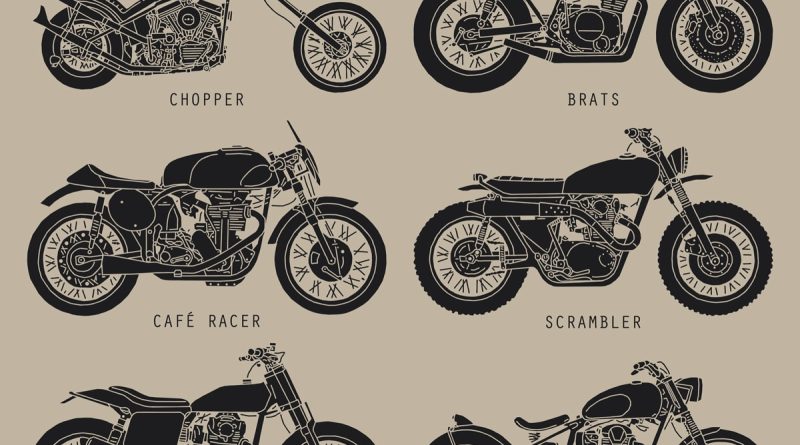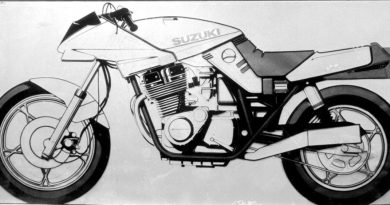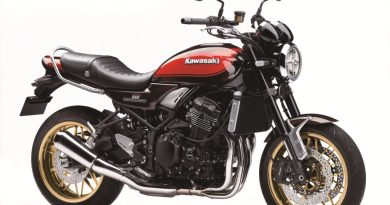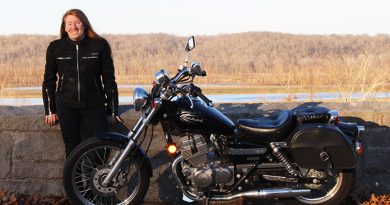Difference Between Custom Bikes – Bobbers, Brats and Choppers Versus Streetfighters, Cafe Racers and Trackers
If you’ve been around motorcycles for longer than you care to remember, it’s easy to take the whole scene for granted. But what if you don’t know your bobbers from your brats or your choppers from your trackers?
Custom motorcycle illustration
Table of Content:
The Bobber
The Café Racer
The Scrambler
The Chopper
The Tracker
The Brat Style
The Streetfighter
The good news is, you’ve come to the right place. Here, you will discover everything you ever wanted to know about custom bikes but were afraid to ask.
If you thought customizing motorcycles was a recent trend, stay tuned. Before we delve into the specifics though, let’s take a quick ride down memory lane.
One of my favorite custom bike builders of all time is Glen Curtiss. Don’t worry if the name isn’t familiar; he hasn’t been around for some time.
Glen Curtiss on his 4000cc V8 powered motorcycle. He managed to beat all competition with a top-speed run of 136.27 mph on 24 January 1907.
In the true spirit of custom bike building, Glen put a V8 aircraft engine in what was nothing more than a rigid pushbike frame.
Sound crazy? That’s not the best part. Curtiss clocked a top speed of 136.27mph, faster than any car, bike or airplane, earning him the title of ‘Fastest Man on the Planet.’ No mean feat for 1907!
Over a century later, the mad gene in custom bike builders is still alive and well, as we can see from Allen Millyard’s 8000cc Dodge Viper-engine custom.
Allen Millyards Viper Motorcycle. Photo: YouTube Screengrab
Allen Millyards Viper Motorcycle. Photo: YouTube Screengrab
In the world of custom motorcycles, it would be easy to say that there is nothing new under the sun. Yet, look at the late great Jesse Rook’s ‘Dinah’ and compare it to the 1948 Imme R100.
Consider this; even those groundbreaking bike builders of yesteryear must have drawn their inspiration from somewhere. So let’s hope the next generation of bike customizers will be fired by past inspirations.
The Bobber
When it comes to custom motorcycles, the bobber is the granddaddy of them all.
Custom BMW R100 Bobber by Renard Speed Shop. Photo: Renard Speed Shop
The origins of the bobber go back to the early 1930s. They came on the scene at a time when lumbering V-twins with heavily balanced fenders were cut down or bobbed for racing.
The evolution process continued with the removal of the road bike’s excess fat. Meanwhile, framework alterations often consisted of lowering the saddle. At this point, the bobber was still predominantly a track bike.
Fast forward to post WWII. Hostilities were over, and a glut of cheap ex-military Harley-Davidsons and Indians kept the youth of America rolling.
Military bikes were packhorses, and almost immediately, riders took to bobbing their motorcycles for the road.
With the back mudguard sawn in half, most riders would ditch the front fender altogether. Peripheral bodywork or luggage frames were next to go.
The classic shape of bare Springer forks, uncluttered pull-back bars, single saddle, and minimalistic back end became a look that defined an era.
Badass Bobber Riders
Bobber riders were badass, or at least that’s what the media wanted everyone to believe. The so-called Hollister riots of 1947 got pinned on a so-called gang of badass bobber riders.
In reality, a lot of these bike gangs consisted of disenfranchised ex-army vets. Men who were seeking the solidarity of their own kind in a society that had more or less turned its back on them.
No article on bobbers could ever conclude without an honorable mention of Kenneth Graeme Howard. Howard, better known as Von Dutch, was the talented and eccentric customizer who began bobbing bikes as far back as 1946.
Kenneth Robert Howard also known as Von Dutch on his 1946 bobber. Von Dutch Originals, LLC
In 2014, even the insinuation of Von Dutch’s involvement in a build saw a classic and elegant Triumph 6T bobber raise $32,000 at auction.
The Café Racer
If the bobber is as American as apple pie, the café racer is a full English breakfast.
Here’s a 1986 Cagiva Alazzurra Made Into Custom Ducati Café Racer
Born in the cobbled backstreets of Britain, the café racer gets its name from the race-styled motorcycles that took a thrashing as they went from café to café.
Motorcycles at this time were cheap and plentiful and still very much the poor man’s vehicle. They provided transportation to work during the week and a means of escaping the grimy city at the weekend.
Early café racers were all British motorcycles. Why? Simple, because any other type of imported bike was either too rare or too expensive.
Motorcycles such as the Triumph Bonneville, BSA A10, Matchless G12, and Norton Dominator were perfect workhorses. What’s more, they were easy to convert to café racer spec.
Influential Isle of Man
Influences came from the Isle of Man TT and the many small production races held up and down the country
On the track, speed and stability were everything, and the same went for the café racer.
A complete café racer conversion consisted of a large capacity aluminum gas tank, clip-on or ace style handlebars, rear set foot controls, a bum-stopper seat, and reverse cone megaphone silencers.
Stock air filters were dumped in favor of mesh-covered bell mouths. Meanwhile, back mudguards were cut down and front mudguards swapped for a small aluminum version.
Innovative corner-cutting was always an option. On my 1968 Bonny, not being able to afford rear sets, I drilled holes in the rear engine plates. Then, removing the rider footrests, I bolted on the passenger footrests and reversed the gear lever.
With exhaust downpipes from an old sidecar outfit, I had a cheap 2 into 1 race pipe. Akrapovic, eat your heart out!
Café Racer Style – Chin on the Tank
It looked a mess, but nobody cared back then. The aim was to get your chin on the tank by any means possible. Café racers were still popular right up to the late ’70s, which is when I built mine. But, by then, the Japanese invasion was in full swing.
Honda FX650 Vigor Café Racer By Kevil’s Speed Shop
Many café racer riders were being lured away by the promise of reaching 100mph while sitting bolt upright.
Not all café racers were as rough looking as mine. This era also spawned classic hybrids such as the Norvin (Norton framed Vincent), Triton (Triumph engine in a Norton Featherbed frame), and Norbsa (usually a BSA A10 in a Norton frame).
Although fading into obscurity in the ’80s, this iconic custom bike style has once again seen its popularity soar.
The Street Scrambler
The street scrambler is a tough-looking, versatile custom motorcycle that looks as if it will keep on going even after the road ends. Yet, with off-road credentials suited to nothing trickier than a dirt track or green lane, this is more of a style statement. Today, it’s a timeless custom bike that oozes retro urban adventure-style vibes.
A Triumph Scrambler. Photo: Triumph Motorcycles
The street scrambler owes its heritage to British riders of the 1930s who would race across farmland on what were more or less stock road bikes. Knobbly tyres, braced handlebars, and high-level pipes were a natural progression for a sport that would evolve into motocross.
On the street, a scrambler with its high ground clearance and upright riding position makes it perfect for navigating pothole-strewn urban landscapes. When it comes to looks, with the originals being barely altered road bikes, scrambler conversions are an easy fix.
Single seats, shortened mudguards, high-level exhaust, and dual-sport tyres take care of the hardware. MX handlebars and minimalistic lights, clocks, and indicators add to the street scrambler’s rough and ready style.
As with all good street customs, motorcycle manufacturers are never far behind with their own unique version. In all fairness, though, this is a genre of custom bikes where the factory really did cross the finish line first.
Triumph TR5 Street Scrambler 1952. Photo: Mecum Auctions
For vintage inspiration, check out a 1952 Triumph TR5, 1967 250 Ducati Scrambler, or 1968 Honda CL350. If you want a more modern twist, look no further than Triumph’s latest 1200 Street Scrambler or top-selling Ducati 1100 Scrambler. Even the Moto Guzzi V7 and BMW’S R nineT come in street scrambler mode.
The Chopper
If you thought the movie ‘Easy Rider’ kicked off the whole chopper craze, think again. Sure, the movie was responsible for giving it legs. Yet the chop building and riding subculture was alive well before the movie’s debut in 1969.
Dragon Bike 1966 Wild Angels chopper. Director Roger Corman, Peter Fonda, and assistant director Peter Bogdanovich. Photo: AIP / Ronald Grant Archive / Mary Evans
It’s not certain as to who built the first long fork chopper or even why. What we do know though, is that it happened in the US. So, like a lot of custom motorcycles, the chop was a creation of the evolutionary ladder. Yet, for clues to its roots, we need to check out ‘Wild Angels.’
This 1966 biker movie featured actor Peter Fonda, who rode a stunning Panhead chopper, labeled the ‘Dragon Bike.’ It got its name due to the eccentric tank artwork painted by Von Dutch.
The Springers kept their stock rake, but the ape hangers and skinny front wheel made them appear longer.
The upswept fishtail exhausts extended past the back wheel. While the top of the sissy bar is almost level with the rider’s head.
The Captain America Chopper Vs The Dragon Bike
Harley-Davidson Easy Rider Captain America Chopper. Photo: Motorcycleusa.com / Courtesy of Business Wire.
The ‘Captain America’ chopper may be more famous, but the ‘Dragon Bike’ is just as important as it marks the transition between the bobber and the chopper.
The fact that the ‘Dragon Bike’ took center stage in 1966 means it was considered to be cutting edge at the time.
Three years later, though, we have the over-exaggerated stretched-out ‘Captain America.’ Can we assume then that in three short years, the evolution of the chopper went into overdrive?
What we do know is that choppers from 1969 onwards became an exaggeration of the norm and the polar opposite of the bobber. Fat front wheels got ditched for 21in hoops, pull-backs became ape hangers, gas tanks tiny, and front ends went crazy.
Larger than Life Vibe
Most custom styles take things away from a motorcycle to produce a specific look. Chop builders however, added and enhanced, creating a larger-than-life vibe.
While it was easy to make longer forks, the engine became tilted back with stock steering geometry. Apart from being bad for oil circulation, the angle didn’t look right.
Early chop riders rode doubled up, bouncing along the road thanks to no rear suspension and reduced front fork travel.
Thinly padded seats bolted to the frame, and the steeply angled longer forks looked like they were always halfway to a wheelie.
Almost every modification to those early choppers made their handling worse or the ride more uncomfortable. But no one cared. Chopper pilots put up with a kick in the spine and crunching teeth from every pothole. Why? Because they looked cooler than a polar bear’s pants, and that’s all that mattered!
Drag strip ingenuity eventually came to the rescue. Quarter mile bike builders knew that extending the front end and raking the steering head to keep the engine horizontal, kept the bike stable and the front wheel down.
This concept transferred to chopper building, but in true chopper-style, all the dimensions became exaggerated.
As a final word on chopper styling and culture, ‘Easy Rider’ took this style of motorcycle, mainstream. However, contrary to poorly researched articles on the subject, Peter Fonda did not design or build the bikes.
The two unsung heroes of that movie were engine specialist Ben Hardy and chop builder Cliff Vaughs. These two African Americans created ‘Captain America’ and the ‘Billy Bike’ From a couple of old LAPD Panheads bought at auction.
Fun fact: The Captain America Chopper used in the movie Easy Rider was sold at auction for $1,350,000 back in 2015.
The Tracker
Although the tracker, or street tracker, is comparatively new, it owes its look to the flat trackers of yesteryear. Flat track racing has been popular in the United States since before WWII.
Super Hooligan racing – notice the missing front brake! Safety what? Photo: Roland Sands Design
In the ’40s and early ’50s, Harley battled with Indian to dominate the sport.
The legendary Harley XR-750 of 1970 was the most successful dirt track tool of all time, and also a design classic. Harley’s dominance in the sport was challenged first by the British then the Japanese. It was this that would alter the layout of the dirt tracker.
At one time, every bike on the start line had a V twin-engine. By the early 60’s and ’70s, though, every conceivable engine layout was powering sideways around the oval.
All sorts of motorcycles from single-cylinder BSA Gold Stars to Kenny Robert’s insane TZ750 four-cylinder two-stroke saw oval action.
What they all had in common was the action stance. Front ends were bare forks, with a chunky front wheel and no brake. Gas tanks were small, almost bobber-like, and the seat was slightly longer than a single saddle. The classic tapering tail piece became an iconic part of the tracker look and the finished product looked ready to pounce.
Too Damn Cool
Dirt trackers were just too damn cool to leave on the track. So taking the look to the street was a given.
While not going the whole hog and ditching the front brake, reducing bulk, upping performance, and adding those iconic tracker styling touches was comparatively easy.
Many aftermarket manufacturers produce tracker kits that will give virtually any bike that street-tough tracker look.
Die-hard tracker fans have their own race series. Moreover although the rivalry between H-D and Indian is still intense, Triumph, Ducati, Yamaha and KTM all duke it out side by side.
The brainchild of custom bike builder Roland Sands, the Super Hooligan Championship encourages a whole new generation of Street tracker fans.
Brat Style
The appeal of the Brat-style bike is obvious. With a limited amount of fettling, you can make a bike yours. Moreover, although it’s possible to replicate the style, no two will ever be quite the same.
Brat style Honda
Taking a stock bike, the obvious removal of bulk is a must, but then the Brat takes its unique stylistic detour. It borrows from virtually every genre of custom motorcycle. The result is a useable street-wise everyday ride that still cuts it as a custom bike.
True to its Roots
While choppers turned into $80K over-blinged garage accessories, streetfighters became clotheshorses for trick engineering. Mainstream manufacturers hijacked the bobber and tracker look, but the Brat stayed true to its street roots.
The brat style look owes its creation to a Tokyo suburb bike shop (actually called Brat Style) owned by old-school customizer Takamine. Brat-style bikes originally started life as small to mid-sized donor bikes.
All the bulk was dumped, and the sub frame cut down to take a shortened flat bench seat. The only deviation from this is a single seat mounted on lowered subframe rails.
Minimal lights and either mini apes or motocross bars complete the look, keeping them cheap to build and highly accessible. Brat bikes invariably use stock suspension, seats are unsprung, and gas tanks are more often than not, stock.
It is permissible to have a small vintage gas tank, but it has to be from an old obscure model.
Bonus Round – The Streetfighter
Discounting Ducati’s legendary 1972 750SS, race replicas hit the streets in earnest in the mid-’80s. Most Japanese manufacturers offered a kind of halfway house sports-tourer.
That same year though, saw Suzuki kick the garage doors off their hinges with the incredible GSX-R 750.
The Gixer performed like a track bike, but with its close-fitting aerodynamic bodywork, it looked the part too. Yet, those expensive plastic panels would lead to the creation of yet another subculture of custom biking, the streetfighter.
Racetrack looks do not a racer make. So it wasn’t long before these expensive bikes along with their riders were sliding sideways down the road. But, unfortunately, coughing up several hundred pounds for a new fairing and clip-ons was not an option for most owners.
Necessity is the Mother of Invention
The streetfighter was born with an old pair of off-road bars hanging around the garage and the cheapest headlight available. Not so much a deliberate styling exercise but more the simple need to keep riding.
While the first streetfighter was born out of necessity, the irony of dirt bike bars on a race bike also appealed to riders looking for any excuse to rage against the machine.
Honda BROS 400 more radical Streetfighter design by K-Speed
The cult of the streetfighter took off in the UK and Germany. Meanwhile, bike designers in Japan, having spent endless wind tunnel sessions creating aerodynamic works of art, must have despaired.
Their melancholy didn’t last long as the marketing men adopted an “If you can’t beat ’em, join them,” mentality and tapped into the whole street streetfighter vibe.
The 1993 Ducati Monster is cited as the first factory streetfighter, and rightly so. It featured a race bike engine at its heart and minimalistic cycle parts. The 1994 Triumph Speed Triple also nailed the look.
1993-94 Ducati Monster 900.
Streetfighters often wear an aftermarket seat and tail unit; Ducati 916 seats were very popular. Plus, an aftermarket exhaust at least twice the decibels of the stock unit. Renthal handlebars with removable crossbar are the tiller of choice. To complete the look small twin headlights were also a popular choice.
In the UK, the genre more or less split in two. The original streetfighter fans were proud to show off their bike’s battle scars, embracing the rough and ready aspect of the original style.
On the flip side, some streetfighter owners polished their frames and added custom billet triple trees and risers.
Top drawer aftermarket wheels and exhaust systems’ became popular additions along with high-tech digital multi-function clocks. Paint jobs ranged from mild to wild.
The Evolution of the Custom Motorcycle
The first custom bike was born when some enterprising owner broke out the spanners and dumped the superfluous fat.
This process has its roots in racing, where removal of stock parts equaled extra speed. Café racers are the obvious beneficiary here. But let’s not forget trackers also give a nod to race bikes.
Ironically the streetfighter started out as a race-style bike before necessity, and an enhanced sense of irony took over.
Bobber styling may have been an offshoot of track bikes, but the reoccurring philosophy of less is more is plain to see. As for choppers, here form eventually took over from function.
No bad thing in itself. The chopper movement has created some of the most iconic customized motorcycles of the 20th century. You only have to consider ‘ Captain America,’ the most recognized motorcycle on the planet.
On the down side, it also mutated into the creation of hideous, unrideable caricatures with laughable price tags. That bubble has now burst, and today, the chopper makes its rightful return to the street.
Last but by no means least, we come to the Brat. It is the least flashy of our custom motorcycle parade, but with its simplicity of style, it is both accessible and affordable.
Custom bikes don’t have to cost 80K or be dripping with trick engineering. But they do have to be different and put a smile on your face every time you throw a leg over them.
Tick these boxes, and you’ve nailed it, viva la difference.
The Ultimate Buyer’s Guide For Motorcycle Gear:
Best Motorcycle Backpacks
Coolest Motorcycle Aviator Goggles
Motorcycle Ankle Boots
GUIDE: Gear For A Motorcycle Roadtrip
Top-10 Retro Motorcycle Gloves
Best Black Leather Jackets
Carbon Fiber Open Face Helmets
The post Difference Between Custom Bikes – Bobbers, Brats and Choppers Versus Streetfighters, Cafe Racers and Trackers appeared first on Old News Club.




